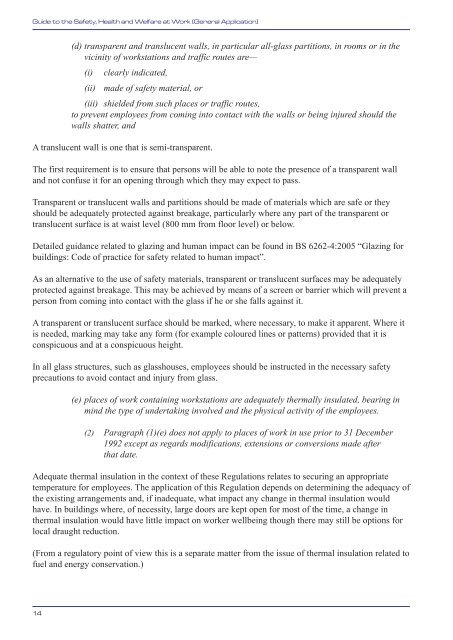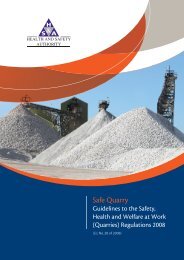Guide to the Safety, Health and Welfare at Work (General Application)
Guide to the Safety, Health and Welfare at Work (General Application)
Guide to the Safety, Health and Welfare at Work (General Application)
You also want an ePaper? Increase the reach of your titles
YUMPU automatically turns print PDFs into web optimized ePapers that Google loves.
<strong>Guide</strong> <strong>to</strong> <strong>the</strong> <strong>Safety</strong>, <strong>Health</strong> <strong>and</strong> <strong>Welfare</strong> <strong>at</strong> <strong>Work</strong> (<strong>General</strong> Applic<strong>at</strong>ion)<br />
(d) transparent <strong>and</strong> translucent walls, in particular all-glass partitions, in rooms or in <strong>the</strong><br />
vicinity of workst<strong>at</strong>ions <strong>and</strong> traffic routes are—<br />
(i) clearly indic<strong>at</strong>ed,<br />
(ii) made of safety m<strong>at</strong>erial, or<br />
(iii) shielded from such places or traffic routes,<br />
<strong>to</strong> prevent employees from coming in<strong>to</strong> contact with <strong>the</strong> walls or being injured should <strong>the</strong><br />
walls sh<strong>at</strong>ter, <strong>and</strong><br />
A translucent wall is one th<strong>at</strong> is semi-transparent.<br />
The first requirement is <strong>to</strong> ensure th<strong>at</strong> persons will be able <strong>to</strong> note <strong>the</strong> presence of a transparent wall<br />
<strong>and</strong> not confuse it for an opening through which <strong>the</strong>y may expect <strong>to</strong> pass.<br />
Transparent or translucent walls <strong>and</strong> partitions should be made of m<strong>at</strong>erials which are safe or <strong>the</strong>y<br />
should be adequ<strong>at</strong>ely protected against breakage, particularly where any part of <strong>the</strong> transparent or<br />
translucent surface is <strong>at</strong> waist level (800 mm from floor level) or below.<br />
Detailed guidance rel<strong>at</strong>ed <strong>to</strong> glazing <strong>and</strong> human impact can be found in BS 6262-4:2005 “Glazing for<br />
buildings: Code of practice for safety rel<strong>at</strong>ed <strong>to</strong> human impact”.<br />
As an altern<strong>at</strong>ive <strong>to</strong> <strong>the</strong> use of safety m<strong>at</strong>erials, transparent or translucent surfaces may be adequ<strong>at</strong>ely<br />
protected against breakage. This may be achieved by means of a screen or barrier which will prevent a<br />
person from coming in<strong>to</strong> contact with <strong>the</strong> glass if he or she falls against it.<br />
A transparent or translucent surface should be marked, where necessary, <strong>to</strong> make it apparent. Where it<br />
is needed, marking may take any form (for example coloured lines or p<strong>at</strong>terns) provided th<strong>at</strong> it is<br />
conspicuous <strong>and</strong> <strong>at</strong> a conspicuous height.<br />
In all glass structures, such as glasshouses, employees should be instructed in <strong>the</strong> necessary safety<br />
precautions <strong>to</strong> avoid contact <strong>and</strong> injury from glass.<br />
(e) places of work containing workst<strong>at</strong>ions are adequ<strong>at</strong>ely <strong>the</strong>rmally insul<strong>at</strong>ed, bearing in<br />
mind <strong>the</strong> type of undertaking involved <strong>and</strong> <strong>the</strong> physical activity of <strong>the</strong> employees.<br />
(2) Paragraph (1)(e) does not apply <strong>to</strong> places of work in use prior <strong>to</strong> 31 December<br />
1992 except as regards modific<strong>at</strong>ions, extensions or conversions made after<br />
th<strong>at</strong> d<strong>at</strong>e.<br />
Adequ<strong>at</strong>e <strong>the</strong>rmal insul<strong>at</strong>ion in <strong>the</strong> context of <strong>the</strong>se Regul<strong>at</strong>ions rel<strong>at</strong>es <strong>to</strong> securing an appropri<strong>at</strong>e<br />
temper<strong>at</strong>ure for employees. The applic<strong>at</strong>ion of this Regul<strong>at</strong>ion depends on determining <strong>the</strong> adequacy of<br />
<strong>the</strong> existing arrangements <strong>and</strong>, if inadequ<strong>at</strong>e, wh<strong>at</strong> impact any change in <strong>the</strong>rmal insul<strong>at</strong>ion would<br />
have. In buildings where, of necessity, large doors are kept open for most of <strong>the</strong> time, a change in<br />
<strong>the</strong>rmal insul<strong>at</strong>ion would have little impact on worker wellbeing though <strong>the</strong>re may still be options for<br />
local draught reduction.<br />
(From a regula<strong>to</strong>ry point of view this is a separ<strong>at</strong>e m<strong>at</strong>ter from <strong>the</strong> issue of <strong>the</strong>rmal insul<strong>at</strong>ion rel<strong>at</strong>ed <strong>to</strong><br />
fuel <strong>and</strong> energy conserv<strong>at</strong>ion.)<br />
14

















